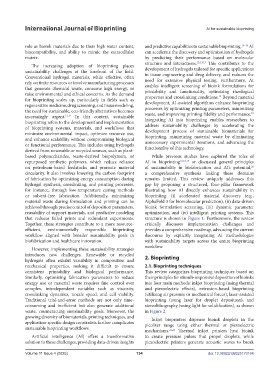Page 142 - v11i4
P. 142
International Journal of Bioprinting AI for sustainable bioprinting
role as bioink materials due to their high water content, and predictive capabilities to sustainable bioprinting. 14–16 AI
biocompatibility, and ability to mimic the extracellular can accelerate the discovery and optimization of hydrogels
matrix. by predicting their performance based on molecular
The increasing adoption of bioprinting places structure and interactions. 12,13,17 This contributes to the
sustainability challenges at the forefront of the field. development of hydrogels tailored for specific applications
Conventional hydrogel materials, while effective, often in tissue engineering and drug delivery, and reduces the
rely on finite resources or involve manufacturing processes need for extensive physical testing. Furthermore, AI
that generate chemical waste, consume high energy, or enables intelligent screening of bioink formulations for
raise environmental and ethical concerns. As the demand printability and functionality, optimizing rheological
14
for bioprinting scales up, particularly in fields such as properties and crosslinking conditions. Beyond material
regenerative medicine, drug screening, and tissue modeling, development, AI-assisted algorithms enhance bioprinting
the need for sustainable, eco-friendly alternatives becomes processes by optimizing printing parameters, minimizing
18
increasingly urgent. 12,13 In this context, sustainable waste, and improving printing fidelity and performance.
bioprinting refers to the development and implementation Integrating AI into bioprinting enables researchers to
of bioprinting systems, materials, and workflows that address sustainability challenges by accelerating the
minimize environmental impact, optimize resource use, development process of sustainable biomaterials for
and enhance scalability without compromising biological bioprinting, minimizing material waste by eliminating
or functional performance. This includes using hydrogels unnecessary experimental iterations, and advancing the
derived from renewable or recycled sources, such as plant- functionality of this technology.
based polysaccharides, waste-derived biopolymers, or While previous studies have explored the roles of
repurposed synthetic polymers, which reduce reliance AI in bioprinting 16,18,19 or discussed general principles
on petroleum-based feedstocks and promote material of sustainability in biofabrication and AI’s potential,
20
circularity. It also involves lowering the carbon footprint a comprehensive synthesis linking these domains
of fabrication by optimizing energy consumption during remains limited. This review uniquely addresses this
hydrogel synthesis, crosslinking, and printing processes, gap by proposing a structured, four-pillar framework
for instance, through low-temperature curing methods illustrating how AI directly enhances sustainability in
or solvent-free fabrication. Additionally, minimizing bioprinting: (i) accelerated material discovery (e.g.,
material waste during formulation and printing can be AlphaFold 3 for biomolecular prediction), (ii) data-driven
achieved through precise control of deposition parameters, bioink formulation screening, (iii) dynamic parameter
reusability of support materials, and predictive modeling optimization, and (iv) intelligent printing systems. This
that reduces failed prints and redundant experiments. structure is shown in Figure 1. Furthermore, the review
Together, these strategies contribute to a more resource- critically discusses implementation challenges and
efficient, environmentally responsible bioprinting provides a comprehensive roadmap, advancing the current
workflow aligned with broader sustainability goals in discourse by explicitly integrating AI methodologies
biofabrication and healthcare innovation. with sustainability targets across the entire bioprinting
workflow.
However, implementing these sustainability strategies
introduces new challenges. Renewable or recycled 2. Bioprinting
hydrogels often exhibit variability in composition and
mechanical properties, making it difficult to ensure 2.1. Bioprinting techniques
consistent printability and biological performance. This review categorizes bioprinting techniques based on
Similarly, optimizing fabrication parameters to reduce their principles for stimuli-responsive deposition of bioinks
energy use or material waste requires fine control over into four main methods: inkjet bioprinting (using thermal
complex, interdependent variables such as viscosity, and piezoelectric effects), extrusion-based bioprinting
crosslinking dynamics, nozzle speed, and cell viability. (utilizing air pressure or mechanical forces), laser-assisted
Traditional trial-and-error methods are not only time- bioprinting (using laser for droplet deposition), and
consuming and inefficient but also generate additional stereolithography (using light for solidification), as shown
waste, counteracting sustainability goals. Moreover, the in Figure 2.
growing diversity of biomaterials, printing techniques, and Inkjet bioprinters dispense bioink droplets in the
application-specific design constraints further complicates picoliter range using either thermal or piezoelectric
sustainable bioprinting workflows. mechanisms. 22,23 Thermal inkjet printers heat bioink
Artificial intelligence (AI) offers a transformative to create pressure pulses that propel droplets, while
solution to these challenges, providing data-driven insights piezoelectric printers generate acoustic waves to break
Volume 11 Issue 4 (2025) 134 doi: 10.36922/IJB025170164

